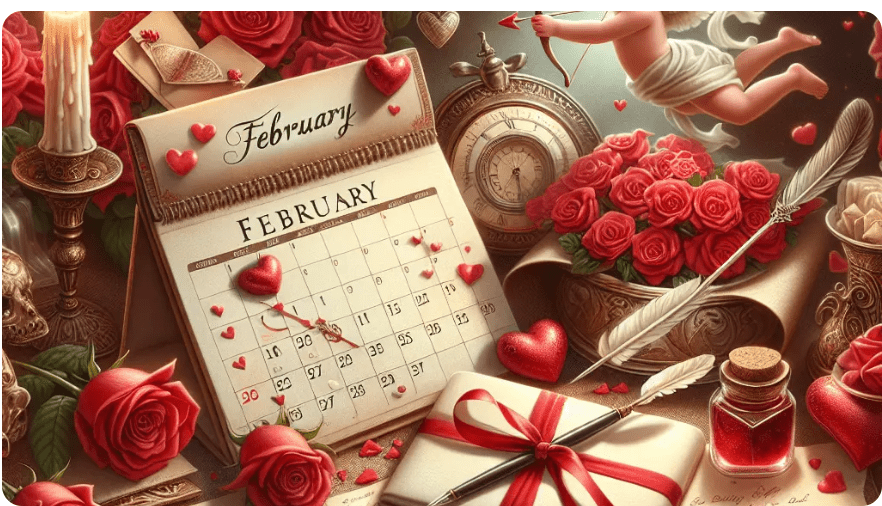
The Fascinating History of Valentine's Day
The Origins of Valentine's Day: A Pagan Festival?
Valentine's Day, celebrated annually on February 14th, has a history that stretches back far beyond the exchange of chocolates and roses. Its roots may lie in the ancient Roman festival of **Lupercalia**, a pagan celebration held in mid-February. Lupercalia was a fertility festival dedicated to **Faunus**, the Roman god of agriculture, and the legendary founders of Rome, **Romulus and Remus**. The rituals of Lupercalia were both intriguing and, by modern standards, unusual. Priests known as **Luperci** would sacrifice goats and dogs, animals symbolizing fertility and purification. They would then cut the goat hides into strips, dip them in sacrificial blood, and use them to gently slap women and crop fields, a practice believed to promote fertility and agricultural abundance.
Interestingly, Lupercalia also included a matchmaking lottery, where young men would draw the names of women from a jar, pairing them as partners for the duration of the festival—or longer, if the match proved successful. While the connection between Lupercalia and modern Valentine's Day is debated, some historians suggest that early Christianity sought to replace pagan traditions with Christian ones. By the late 5th century, Pope Gelasius I abolished Lupercalia and declared February 14th as **St. Valentine's Day**, intertwining the date with Christian values while retaining its association with love and fertility.
Saint Valentine: The Man Behind the Name
The name "Valentine" is synonymous with love, but the historical figure behind the holiday remains shrouded in mystery. In fact, there were multiple Saint Valentines recognized by the Catholic Church, and their stories are a blend of history and legend. One of the most popular accounts involves **Saint Valentine of Rome**, a priest who lived during the 3rd century under the reign of Emperor Claudius II. According to legend, Claudius banned marriages for young men, believing that single men made better soldiers. Valentine defied this decree by secretly performing marriages for young couples. When his actions were discovered, he was arrested and eventually executed on February 14th.
Another tale suggests that Valentine was imprisoned for helping Christians escape Roman persecution. During his imprisonment, he is said to have fallen in love with the jailer's daughter, to whom he wrote a farewell letter signed "From your Valentine"—a phrase that endures to this day. While the historical accuracy of these stories is uncertain, they all emphasize themes of love, sacrifice, and devotion, which have become central to the holiday.
The Role of Geoffrey Chaucer in Romanticizing Valentine's Day
The association of Valentine's Day with romantic love didn't emerge until the Middle Ages, and much of the credit goes to **Geoffrey Chaucer**, the famed English poet. In his 14th-century poem **"Parliament of Fowls"**, Chaucer wrote, "For this was on Saint Valentine's Day, when every bird cometh there to choose his mate." This line is one of the earliest known references linking Valentine's Day to romantic love. Chaucer's work was written during a time when the concept of **courtly love**—a chivalric expression of admiration and devotion—was flourishing in European culture.
The idea of Valentine's Day as a celebration of love gained traction among the nobility, who began exchanging love notes and tokens of affection. Medieval literature, including works by Chaucer and his contemporaries, played a significant role in shaping the romantic traditions we associate with the holiday today. These early literary references laid the groundwork for Valentine's Day to evolve into a celebration of love and partnership.
The Evolution of Valentine's Day Traditions Over the Centuries
Valentine's Day traditions have undergone significant transformations over the centuries. During the Middle Ages, the exchange of handwritten love notes became a popular custom, particularly among the upper classes. These notes, often adorned with poetic verses, were the precursors to modern Valentine's cards. By the 18th century, the tradition had spread to the general population, with people exchanging small tokens of affection such as flowers and sweets.
The Victorian era saw the commercialization of Valentine's Day take off. Advances in printing technology made it possible to produce **mass-printed Valentine's cards**, which became widely available and affordable. These cards often featured elaborate designs, including lace, ribbons, and romantic imagery. The Industrial Revolution further fueled the holiday's popularity by making gifts like chocolates and jewelry more accessible. By the late 19th century, Valentine's Day had become a firmly established tradition, celebrated by people of all social classes.
Valentine's Day Around the World: Unique Cultural Celebrations
While Valentine's Day is widely celebrated, its customs vary significantly across the globe, reflecting local cultures and values. In **Japan**, for example, the holiday revolves around chocolate. Women traditionally give chocolates to men, with different types of chocolate signifying romantic interest or platonic friendship. A month later, on **White Day**, men reciprocate with gifts, often of greater value. In **Denmark**, people exchange pressed white flowers called **snowdrops** and send humorous, anonymous love notes known as **gaekkebrev**.
In **South Korea**, Valentine's Day and White Day are part of a trilogy of love-themed holidays, culminating in **Black Day** on April 14th, when singles gather to eat black noodles and celebrate their independence. Meanwhile, in **Mexico**, Valentine's Day is known as **El Día del Amor y la Amistad** (The Day of Love and Friendship), emphasizing both romantic and platonic relationships. These diverse traditions highlight the universal appeal of love while showcasing the unique ways it is celebrated around the world.
The Commercialization of Valentine's Day in Modern Times
In the 20th century, Valentine's Day underwent a dramatic transformation, becoming one of the most commercialized holidays of the year. The rise of mass marketing and advertising played a pivotal role in shaping modern expectations for the holiday. Companies like **Hallmark** capitalized on the demand for Valentine's cards, while confectionery giants like **Cadbury** and **Hershey's** popularized heart-shaped chocolates. The floral industry also saw a significant boost, with red roses becoming the quintessential symbol of love.
Today, Valentine's Day is a multi-billion-dollar industry, with consumers spending on everything from jewelry and dining experiences to personalized gifts. According to the **National Retail Federation**, Valentine's Day spending in the United States alone exceeds $20 billion annually. While the commercialization of the holiday has drawn criticism, it has also made Valentine's Day more accessible, allowing people to celebrate love in ways that suit their preferences and budgets.
Criticism and Alternatives to Valentine's Day
Despite its popularity, Valentine's Day is not without its critics. Many people view the holiday as overly commercialized, arguing that it places undue pressure on couples to spend money and meet societal expectations. Others feel that it excludes those who are single or not in romantic relationships. In response, alternative celebrations have emerged. **Singles' Day**, originating in China, is a day for individuals to celebrate self-love and independence. Similarly, **Galentine's Day**, popularized by the TV show *Parks and Recreation*, encourages women to celebrate their friendships on February 13th.
There is also a growing trend toward celebrating platonic relationships and self-love on Valentine's Day. People are increasingly using the holiday as an opportunity to practice self-care, spend time with friends, or express gratitude to loved ones beyond romantic partners. These alternatives reflect a broader shift toward inclusivity and a redefinition of what it means to celebrate love.
Fun Facts and Lesser-Known Trivia About Valentine's Day
Valentine's Day is full of fascinating trivia and quirky traditions. Did you know that the first box of **heart-shaped chocolates** was introduced by Richard Cadbury in the 1860s? Or that **Cupid**, the cherubic symbol of love, originated from **Eros**, the Greek god of desire? Each year, approximately **145 million Valentine's cards** are exchanged in the United States alone, making it the second most popular card-sending holiday after Christmas.
In some countries, Valentine's Day traditions take a humorous turn. In **South Africa**, women pin the names of their crushes on their sleeves, a custom inspired by an ancient Roman festival. Meanwhile, in **Finland**, Valentine's Day is called **Ystävänpäivä**, or "Friend's Day," and focuses on celebrating friendships rather than romantic relationships. These fun facts and traditions add depth and charm to the holiday, reminding us that love comes in many forms.
